Content
Hosta Mediovariegata (wavy) is a unique ornamental plant. With its help, you can plant greenery and decorate a personal plot or complement a flower arrangement. In order for a perennial to grow well, it is necessary to observe a number of conditions and properly care for the plant.
Description of wavy hosts MediaVariety
The variety was bred in Japan in 1930. This fast-growing perennial plant belongs to the lily family.
Outwardly, it is a hemispherical bush. The average height of an adult hosta "Mediovariyegata" is 50 cm, the width of the bushes grows to 60-70 cm.
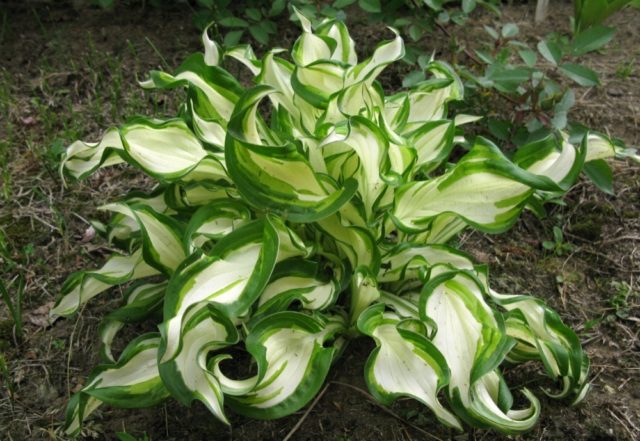
Hosta decorates gardens and household plots with its flowering
"Mediovariegata" is dark green in color. During the growing season, the host has a large number of stems and leaves. In spring, before the onset of hot weather, the color of the shoots is dark green. In summer, with abundant sunshine, "Mediovariyegata" brightens up.
The leaves have a raised, pointed edge. The surface in the center is white with a green border on the sides. The length of the sheets is up to 15 cm.
In June, less often at the end of May, the plant blooms. As you can see in the photo of the hosts of "Mediovariety", a large number of light purple flowers appear on the bushes. They are funnel-shaped and hold on long (up to 70 cm) pedicels.
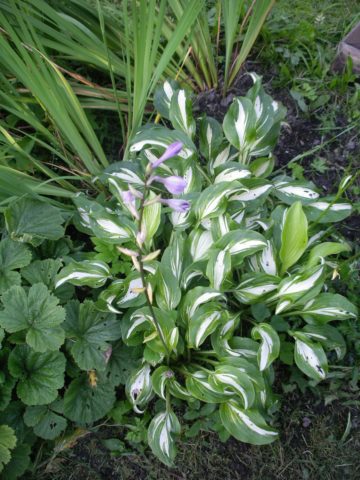
"Mediovariygata" does not create problems in maintenance, frost-resistant and has an attractive decorative appearance
It is recommended that the host "Mediovariegata" grow in a shaded area or in partial shade. The plant is uncomfortable in the sun. Due to the abundant lighting, moisture evaporation accelerates, especially in hot weather. The lack of liquid can cause serious damage to the bush, especially during the period of bud formation. With a lack of moisture, the tips of the leaves of the hosta darken.
"Mediovariegata" is not sensitive to low temperatures. Therefore, it can be grown in any region. The "Mediovariyegata" bush tolerates frost well down to -30 degrees for a long period of time.
Application in landscape design
This hosta variety is very beautiful. Thanks to the unique color of the leaves, "Mediovariety" can be used as an independent decorative element. Bushes are often planted on lawns, near water bodies and fruit trees. The plant will be a good solution for zoning when you need to visually divide the area.
"Mediovariety" looks good against the background of other hosts. The main thing is that the neighboring plants are of the same color.
When disembarking, the host is best combined with:
- irises;
- peonies;
- gladioli;
- phlox;
- geychers;
- lilies;
- astilbe;
- primroses;
- ferns.

The plant is able to achieve decorative attractiveness only by the 4th year of life.
Tall ornamental plants should not be planted too close to the host, otherwise it may become invisible in the overall composition.
Wavy hosta is ideal for growing in rock gardens. There they should be combined with other low perennials or annuals.
Breeding methods
The most effective method is to divide the bush. From the "delenka" you can get a full-fledged healthy plant for the next year, after planting in the ground.
Division method:
- Choose a healthy mother bush from the age of 4 years.
- Dig up the plant.
- Remove soil from roots.
- Use a sharp knife or pruning shears to separate the “delenka” with 3 or more buds.
- Lubricate the cut with wet sand.
- Return the mother bush to fertilized soil.

It is better to divide hosta bushes in spring and late summer.
For propagation of wavy hosts "Mediovariygata", the method of grafting is suitable. It allows you not to dig out the bush. Hosta can be propagated by seed, but this process is time consuming and laborious.
Landing algorithm
Garden shops offer seedlings "Mediovariygaty" obtained by the method of division. Before buying planting material, it must be carefully examined. There should be no foci of decay, damage and cracks. A prerequisite is the presence of 3 more kidneys.
Wavy "Mediovariygata" grows well in different types of garden soils. The main condition is a suitable level of humidity and the presence of drainage to prevent stagnation of the liquid. Best of all, "Mediovariyegata" grows in soil containing a lot of humus. The optimum acidity level is 5-6 pH.
Planting stages:
- At the chosen place, dig a hole 30 cm deep and 40 cm wide.
- Place expanded clay or other drainage layer on the bottom.
- Mix garden soil with a little peat and compost.
- Pour the potting mix into the hole, leaving 8-10 cm from the surface.
- Place the "delenka" inside.
- Sprinkle it with earth so that the buds are at a depth of 3-4 cm.
- Water the plant.

Hosta does not feel well in sandy and heavy loamy substrate
From above, you can sprinkle the planting site with dry crushed compost or tree bark. With their help, premature evaporation of moisture can be prevented.
"Mediovariety" is planted in groups of several bushes. For 1 sq. m. there should be no more than 6 bushes.
Growing rules
The plant does not need specific care. A minimum set of activities is possible, which is enough for the host to grow well.
The place where the bush is located must be regularly cleared of weeds. This is done by hand or using a garden tool. Fast growing weeds with long, curling shoots are especially dangerous. They can twine around the host, after which it will take a lot of effort to free the bush.
Since "Mediovariygata" is a moisture-loving plant, regular watering is required. It is carried out taking into account climatic conditions. In the spring, the bushes are watered with settled water 3-4 times a month. In summer, when the weather is hot and there is no precipitation, the frequency is increased to 2-3 times a week. Each bush requires at least 10 liters of water.
From time to time "Mediovariyegata" needs a sanitary haircut. Withering or discolored leaves, dried shoots are cut from the bushes.
In the spring, the hostu is fed with organic fertilizers. Compost, humus, peat, tree bark and bird droppings are used. Organic fertilizing enriches the soil with nutrients for a long period of time. For the winter, these types of fertilizers are not recommended.
Mineral feeding is also carried out in early spring. To do this, use liquid or granular products containing potassium, phosphorus and nitrogen. Re-fertilization is carried out in the summer, after flowering, as well as in the fall, when persistent cold weather sets in.
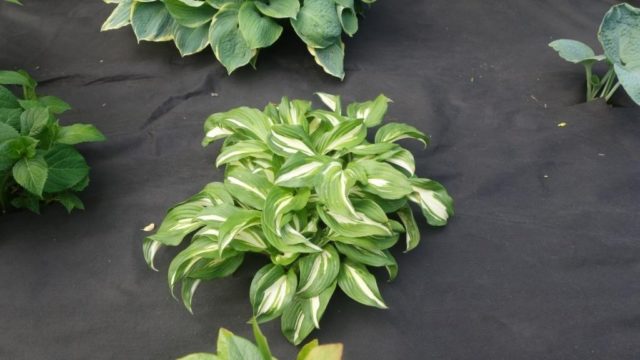
Before planting, the soil must be well dug up with organic fertilizers.
To preserve moisture in the soil, mulching is carried out. This procedure is carried out simultaneously with loosening the soil. The depth of processing is at least 8 cm. As mulch, bark, peat, dry compost and straw are used. Another option is a mixture of dry leaves, sawdust and hay.
Preparing for winter
In the southern regions, where temperatures rarely drop below -20 ° C, preparation for the cold season is not required. In the fall, it is recommended to apply mineral fertilizer, to mulch the soil. At the end of October, foliage is removed from the hosts and the stems are cut, leaving basal shoots 3-5 cm long.
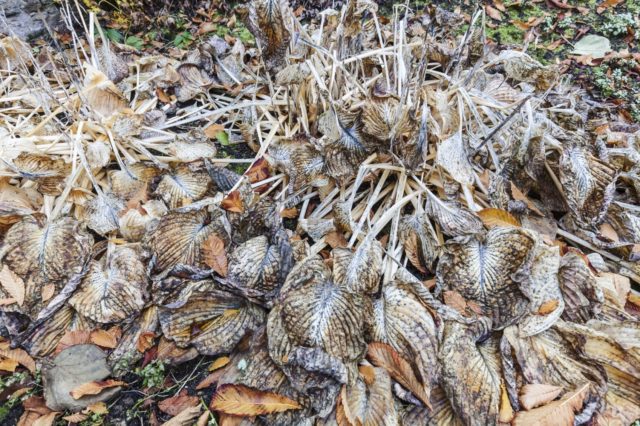
The stem of the hosta should be cut off immediately after the end of the flowering phase.
If a cold winter is predicted, it is better to cover the plant. For this, spruce branches and pine branches are used. You can cover the bush with dry foliage, sawdust, straw or hay.
Features of preparing hosts for the winter season:
Diseases and pests
Hosts are practically not susceptible to infectious lesions. Bacterial and fungal diseases are rare. The main reason is improper care or the presence of infected plants in the immediate vicinity.
Common diseases:
- root rot;
- phyllostictosis;
- gray rot;
- rust;
- viral lesions.
In the course of treatment, the affected areas of the plant must be removed. The bush, as well as the soil around, is treated with a fungicide. During the treatment period, watering is temporarily reduced.
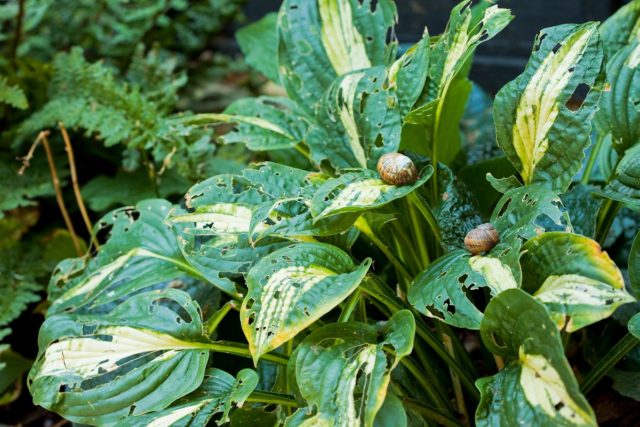
Mulching from shell rock and broken rubble can help slugs
The most common pests of "Mediovariyegata" are aphids, snails, scoops, slugs and nematodes. They usually appear in dry weather. As a treatment, the hostu, as well as neighboring plants, are sprayed with insecticides. Preventive treatment is recommended every spring.
Conclusion
Hosta Mediovariegata is a popular ornamental plant. This variety has become widespread due to its ease of care, unpretentiousness, resistance to negative factors. "Mediovariegatu" can be grown by both experienced and novice growers. Such a hosta is ideal for landscaping areas and creating flower arrangements.








